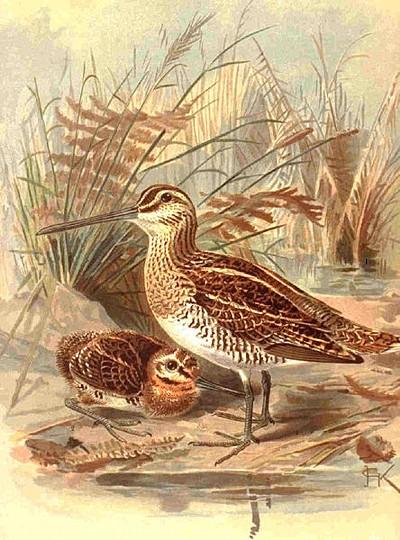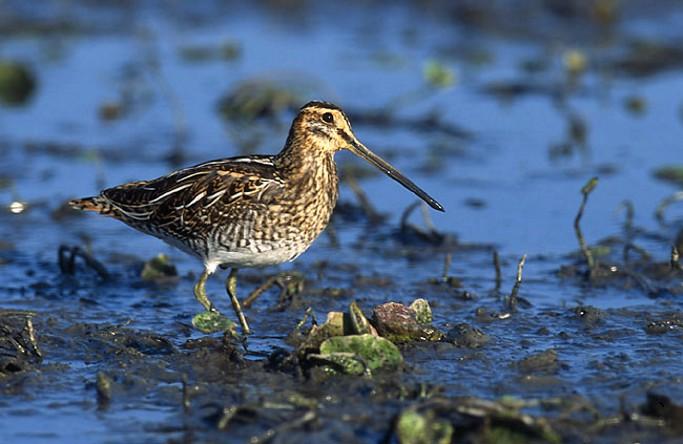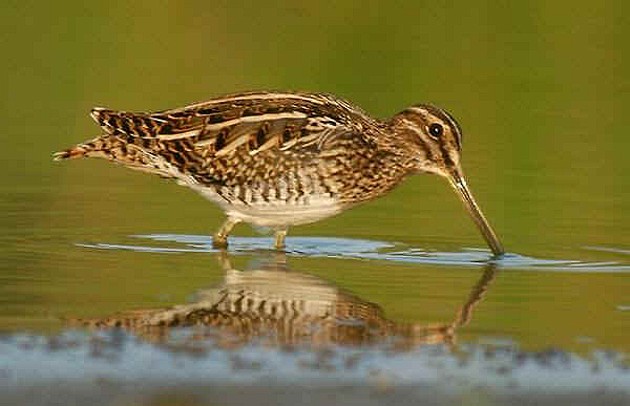Lessico
Beccaccino
Gallinago gallinago / Capella gallinago

Beccaccino
è diminutivo di beccaccia = dal lungo becco![]() . Uccello caradriiforme (Gallinago
gallinago o Capella gallinago) della famiglia Scolopacidi. È una
specie tipica degli ambienti acquitrinosi, lunga sino a circa 25 cm, munita di
un becco assai lungo e sottile. Il colore prevalente è il bruno, con toni
neri e fulvi sul dorso; il capo è percorso, nel senso della lunghezza, da
striature più chiare. Il beccaccino, assai diffidente e pauroso, vive in
piccoli branchi. Per il volo difficile e irregolare, nonché per la bontà
delle carni (si cucina prevalentemente allo spiedo, conservando così lo
squisito sapore e il delicato aroma che lo distinguono), è assai ricercato
dai cacciatori. Vive in buona parte dell'Europa e dell'Asia, portandosi
d'inverno in territori più meridionali; in Italia è di passo alla fine
dell'inverno e in primavera. Si ciba di invertebrati, estratti dal suolo umido
e dalla melma; le covate sono due e comportano, ognuna, la deposizione di 4
uova in un avvallamento del terreno.
. Uccello caradriiforme (Gallinago
gallinago o Capella gallinago) della famiglia Scolopacidi. È una
specie tipica degli ambienti acquitrinosi, lunga sino a circa 25 cm, munita di
un becco assai lungo e sottile. Il colore prevalente è il bruno, con toni
neri e fulvi sul dorso; il capo è percorso, nel senso della lunghezza, da
striature più chiare. Il beccaccino, assai diffidente e pauroso, vive in
piccoli branchi. Per il volo difficile e irregolare, nonché per la bontà
delle carni (si cucina prevalentemente allo spiedo, conservando così lo
squisito sapore e il delicato aroma che lo distinguono), è assai ricercato
dai cacciatori. Vive in buona parte dell'Europa e dell'Asia, portandosi
d'inverno in territori più meridionali; in Italia è di passo alla fine
dell'inverno e in primavera. Si ciba di invertebrati, estratti dal suolo umido
e dalla melma; le covate sono due e comportano, ognuna, la deposizione di 4
uova in un avvallamento del terreno.
Gallinago gallinago

Il Beccaccino (Gallinago gallinago Linnaeus, 1758) è un uccello della famiglia Scolopacidae. Ha un becco lungo e sottile, raggiunge in media una lunghezza di 28 cm e un peso di 250 g con una apertura alare di 49 cm. Ha un piumaggio variegato con tinte brune, rossicce e crema. Il capo è compresso lateralmente, gli occhi molto spostati indietro. Zampe lunghe e verdastre. Coda con poco bianco ai lati.
Praticamente, tranne che in Oceania, è visibile in tutto il mondo. In Italia ci sono rari casi di nidificazione in ambienti palustri, durante la migrazione e lo svernamento gli habitat sono diversi, tranne che nei boschi si adatta dovunque, anche se predilige paludi, prati umidi, praterie e risaie. Volo di levata a zig zag. Sfugge al pericolo acquattandosi sul terreno e mimetizzandosi perfettamente con la vegetazione e con il suolo. Durante le parate nuziali emette un U-U-U-U, mentre quando è in volo si possono udire degli gnec-gnec.
Si ciba di molluschi, crostacei, vermi, insetti e vegetali. Nidifica tra l'erba e i giunchi, a volte tra l'erica. Vola in piccoli stormi. La specie ha un ampio areale geografico di distribuzione, stimato in oltre 10.000.000 km², con una popolazione mondiale stimata di 5.400.000 - 7.500.000 esemplari. In base ai criteri della IUCN Red List è considerata a basso rischio (LC).

The Common Snipe (Gallinago gallinago), also called a Fantail Snipe, European Sandpiper, or weet-weet, is a small, stocky shorebird. The breeding habitat is marshes, bogs, tundra and wet meadows in Iceland, the Faroes, northern Europe and Russia. European birds winter in southern Europe and Africa, and Asian migrants move to tropical southern Asia.
Adults are 23-28 cm in length with a 39-45 cm wingspan. They have short greenish-grey legs and a very long straight dark bill. The body is mottled brown on top and pale underneath. They have a dark stripe through the eye, with light stripes above and below it. The wings are pointed.
This species closely resembles the Wilson's Snipe, Gallinago delicata, of North America, which was until recently considered to be a subspecies Gallinago gallinago delicata of Common Snipe. The latter differs from the North American species in having a wider white edge to the wings, and seven pairs of tail feathers instead of eight. There are two other races of Common Snipe; G. g. faeroeensis in Iceland, the Faroes, Shetland and Orkney, and G. g. gallinago in the rest of the Old World. The latter is a taxon to which the Agreement on the Conservation of African-Eurasian Migratory Waterbirds (AEWA) applies.
This well camouflaged bird is usually shy and conceals itself close to ground vegetation and flushes only when approached closely. They fly off in a series of aerial zig-zags to confuse predators. Snipe hunters, therefore, needed to be very skilled to hunt these birds and they came to be called snipers - a term later adopted by the military. These birds forage in soft mud, probing or picking up food by sight. They mainly eat insects and earthworms, also plant material.
The male performs "winnowing" display during courtship, flying high in circles and then taking shallow dives to produce a distinctive sound - which has given the bird its Finnish name taivaanvuohi, "sky goat", because the sound is similar to the baaing of a goat. Common Snipe nest in a well-hidden location on the ground.